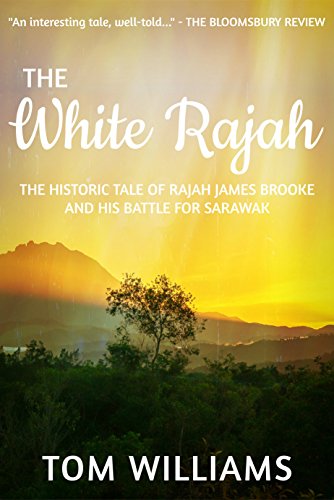People often ask writers where they get their ideas. In the case of my first novel, ‘The White Rajah’, I got the idea in Borneo.
My mother-in-law used to live in Singapore. We went out to visit her one Christmas and my wife gave me a trip to Sarawak as a Christmas present.
I’d never even heard of Sarawak. It turned out to be on the north coast of Borneo, over toward the left hand end. Unlike most of the island, it’s part of Malaysia rather than Indonesia.
Back in those days there wasn’t a lot of tourism in Sarawak. We stayed in the Holiday Inn, which was practically the only hotel in the tiny capital, Kuching. Kuching wasn’t what we’d come for, though. We’d come to see the indigenous people: the Dyaks.
We took a boat upstream from Kuching to a longhouse by the river. It was everything that you read about in books. Immensely long, it stood on stilts. Pigs and chickens lived under the house. Up above them there was a communal hall that stretched the length of the building with private rooms on one side and an open veranda on the other. The whole thing was put together from timber and bamboo and thatch with nothing quite fitting, so there were plenty of gaps for the air to circulate. For the first time in a while, we were able to sleep without the benefit of air conditioning or ceiling fans.
The next day we carried on upriver. We set fish traps to check when we made our way back the following day. We found a mouse deer that had ventured too far from the trees and trapped him for the pot. Arriving at the next longhouse we were shown how to use a blowpipe while more serious hunters slipped off into the jungle with a rifle, returning with a monkey that they spit roasted. Less adventurous gourmets guided us round fields of tapioca and sugar cane.
It was a short trip but a memorable one. Even while we were there, the way of life we were seeing was vanishing. Electricity arrived at the second longhouse pretty much the same day as we did and the tribe gathered to watch television for the first time. Someone sold me their ceremonial sword to raise money for the outboard motor that would supplement paddle-power on their canoe. Boarding schools of brick and concrete were being built so that the Dyak children could have a proper education. And, though we did not know it at the time, deforestation was threatening the traditional Dyak way of life.
I’ve never been back. I doubt that the Sarawak I briefly visited still exists. But its beauty haunted me. I had had a tiny glimpse of a way of life that had existed for generations, but which was now vanishing. When I decided to write a book that deals in part with the changes that colonialism brought to remote societies, it gave me the chance to revisit that distant land in my memory and through books and photographs, some modern, some dating back over a century and a half.
The result was ‘The White Rajah’, a fictionalised account of a real-life Victorian, James Brooke. Like me, he had visited Borneo and been enchanted with the place. Unlike me, he stayed. Involving himself in local politics, he used a combination of diplomacy and force to impress the local overlords to the point where they made him ruler of a tiny bit of their kingdom. That bit was Sarawak and, to this day, the country (now one of the Malay states) is defined by its connection to Britain, while all around are places which were part of the Dutch empire and which are now part of Indonesia.
Where do I get my ideas? Well, at least some of them, sitting in a canoe drifting through a jungle.

‘The White Rajah’ is available from Amazon in both paperback and Kindle formats. Please note that it has a different cover in North America.


Very atmospheric, Tom.
Nice to see you reading the blog, Paul. I’m glad you enjoyed it.